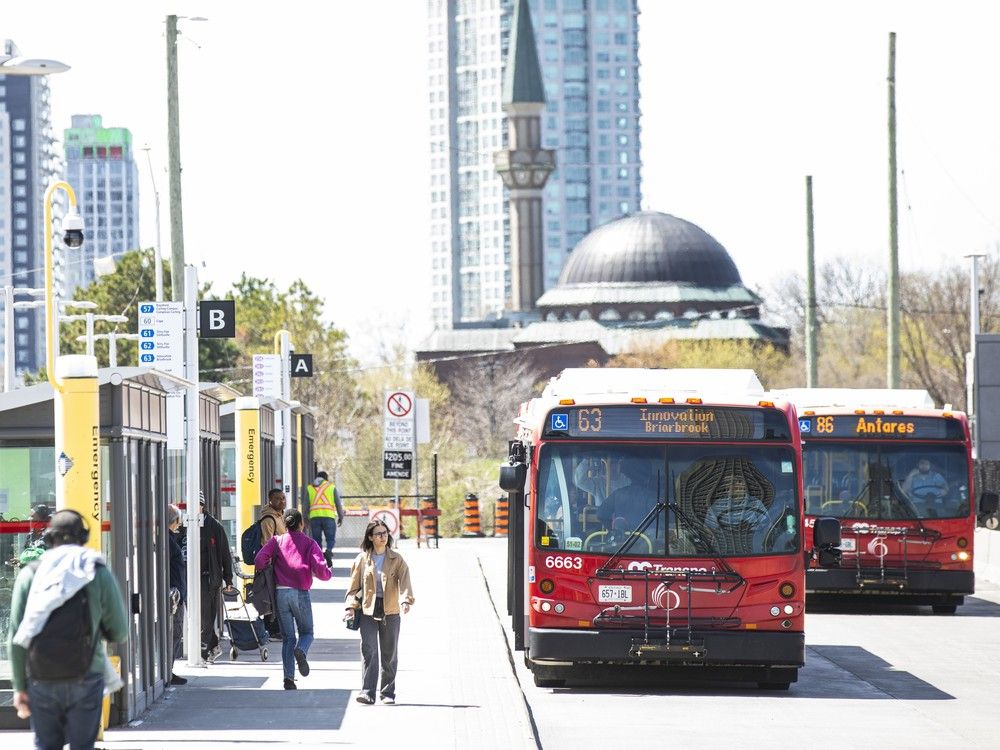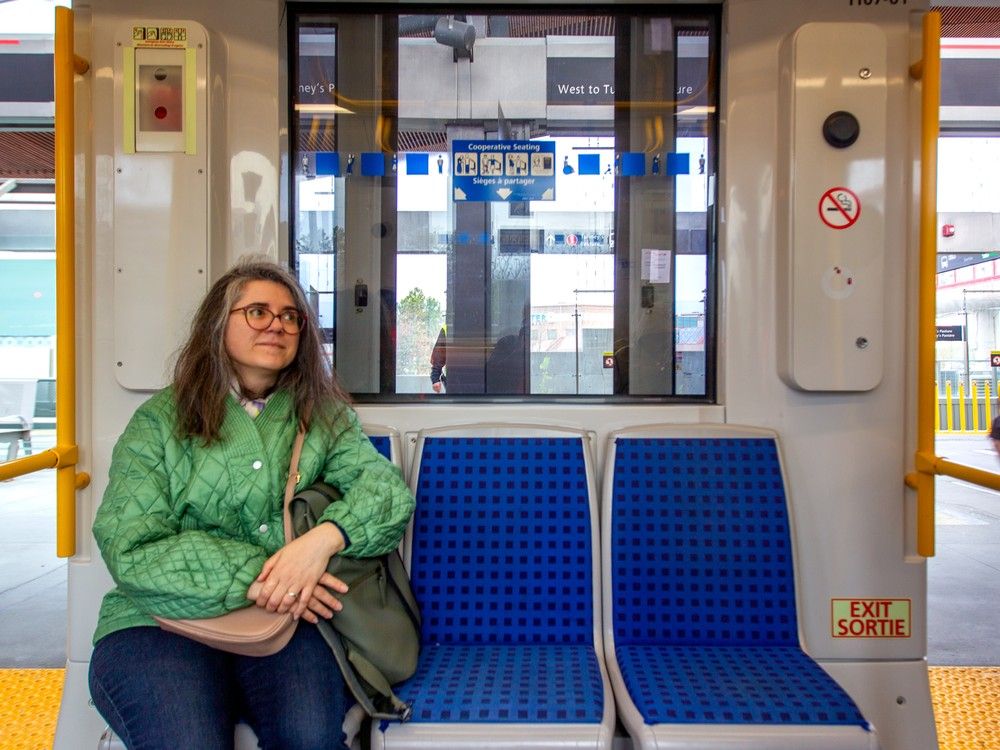This is a story of an OC Transpo commute during which absolutely nothing went wrong.
It took place on a Friday morning, when rush-hour traffic is lighter than is typical at mid-week. The weather was fine: there was no snow, sleet, ice, rain or smoke. A
sinkhole didn’t open up
on Highway 174 and swallow the #38 Blair bus. The LRT train didn’t break down. And Ottawa’s recently launched construction season didn’t unduly affect the #80 Barrhaven Centre bus as it wended its way from Tunney’s Pasture to Leikin Drive.
Additionally, there were no calisthenics required to make connections, while the longest delay was a nine-minute interlude waiting for the #80 bus at Tunney’s Pasture.
In other words, you couldn’t have asked for better commuting conditions. It was, according to Claudia Biasolo, with whom I rode shotgun that day, “the perfect scenario.”
And yet, Biasolo’s odyssey from Orléans to her federal public service job in Barrhaven still took one hour and 50 minutes, including the 10-minute walk from her home near Place d’Orléans to start it off.
Like driving to Kingston
That’s a long time for a trip that takes 33 minutes by car in the morning rush hour. Biasolo says her transit commute typically takes a bit longer than what I witnessed — about two hours — and the return trip slightly longer still. Occasionally, when the train and bus segments aren’t as well-synchronized, the delays are compounded. If two hours is normal, two-and-a-half isn’t uncommon.
“I could commute daily to Kingston or Montreal in the time it takes me to get to work,” she says.
She isn’t alone. Many customers are frustrated by longer commutes as OC Transpo cuts routes and services. In Biasolo’s case, it takes her about twice as long to get to work as it used to.
“I hear that some people say it’s more efficient,” she says of OC’s recent route changes, “but I haven’t met those people yet. We pay more and we get less.”
There was a time — before the O-Train was little more than a dysfunctional glimmer — when Biasolo could hop on the #199 bus at Place d’Orléans and take it straight to work in about an hour. The commuter route, introduced in 2009, only did two daily runs each way, but Biasolo made it work — she’s uncomfortable driving and has never owned a car, so when she moved from Quebec to Ontario years ago, she let her driver’s licence lapse. An hour-long commute was part of the price she was willing to pay to stay at a job she enjoys while living in a neighbourhood she loves.
But bit by bit, the journey took up more of her day. During O-Train construction, the #199’s route got longer as it travelled through more of the south and west ends of the city. Her hour-long trip turned into 75 minutes.
The arrival of LRT made matters worse. The #199 route was truncated to go only as far east as Hurdman station. Biasolo thus first had to take a bus from Place d’Orléans to Blair station, then transfer to the O-Train to Hurdman station to board the #199 bus. Her 75-minute commute suddenly stretched to an hour-and-a-half.
Last month, as part of OC’s
“New Ways to Bus”
service changes, the #199 route was eliminated entirely. Biasolo’s journey to work, which should logically stay south of the Highway 174/417 corridor, now goes all the way downtown before deflecting, pinball-style, back to the ‘burbs.
(There are, admittedly, other options: OC Transpo’s online route planner suggested I take three buses and two trains to get from Place d’Orléans to Barrhaven. That journey, on paper, is about 20 minutes faster, but seriously — three buses and two trains? Was there no way to fit in a helicopter ride and Segway too?)
Biasolo describes her daily commute as “a mix of frustration and resignation” and even, sometimes, “anxiety-inducing.”
Riders have little choice
Meanwhile, there are those occasional mornings when things really go bad, like when Biasolo reaches Blair station and finds herself waiting more than 15 minutes for the train, an indication that replacement buses are on their way. When that happens, she returns home. As part of the post-COVID world, she works from home two days a week, and her employer is understanding and flexible.
“It’s like OC Transpo reorganized routes so you HAVE to take the train,” Biasolo says. “Riders don’t appear to have a choice.”
It’s her choice to live and work where she does, and it’s her decision not to drive. But it’s not like she’s living in a forest at the city’s farthest reaches. She’s in Orléans, after all, along with 125,000 other Ottawa residents. And she lives very close to Place d’Orléans, the area’s most significant OC Transpo hub. For a commute to take twice as long as it did prior to Ottawa getting LRT is not a reasonable outcome.
“You do,” she adds wryly, “get a nice view of the city.”

Indeed. Similar to how Ottawa mayors past and present like to illustrate the city’s vast post-amalgamation geography by listing the Canadian cities — Toronto, Montreal, Calgary, Edmonton and Vancouver — that could fit inside its boundaries, OC Transpo, judging from Biasolo’s experience, seems to want to SHOW riders Ottawa’s expanse every time they take a trip.
Biasolo has twice emailed OC Transpo — once through Coun. Matt Luloff and once directly — to specifically seek its rationale in eliminating the #199 without a replacement. On each occasion, she received a cut-and-paste, platitude-laden response that failed to address her specific concerns.
“Some customers,” one response noted, “will have to travel further to the bus stop or have additional transfers to buses or trains. WE UNDERSTAND THAT THESE CHANGES CAN HAVE AN IMPACT ON OUR CUSTOMERS’ DAILY ROUTINES AND WE ARE ACTIVELY WORKING TO ENSURE CUSTOMERS ARE AWARE OF THE NEW NETWORK.” (Emphasis mine). In other words, too bad, so sad.
Biasolo’s husband similarly reached out, and received a similar cookie-cutter reply.
“I read your reports,” Biasolo responded to one of OC’s replies. “Did you survey people on which routes to cut or reduce service? It could have proved more useful than asking people if they would like the bus to be on time.”
That was a month ago, on April 14. She hasn’t heard back.
So she’ll continue waking up at 5:30 a.m. to get to work for 8, and back home 10 hours later, at 6 p.m. She’s nine years from retiring, and says she’d consider looking for different work assignments with the same employer if it could be at another, closer office.
That’s not how this is supposed to work. Public transit should be a service that makes residents’ lives easier — not a daily test of patience, endurance and logistics. It shouldn’t force people to weigh early retirement or job changes just to avoid spending four hours of each working day in transit.
Biasolo isn’t asking for the impossible. She wants reliability and planning that puts riders at the centre of decisions. Instead, OC Transpo offers her silence, detours — and the scenic route.
Our website is your destination for up-to-the-minute news, so make sure to bookmark our homepage and sign up for our newsletters so we can keep you informed.
Related
- Sythe: ‘Worse ways to bus’ — OC Transpo has now made it harder to get to the airport
- People have lost trust in OC Transpo, riders group says on free-fare weekend
- Pellerin: OC Transpo’s bus changes will frustrate you even more



